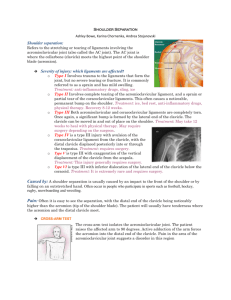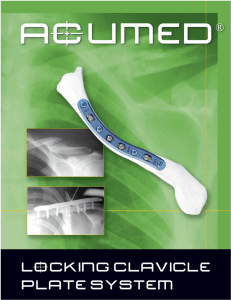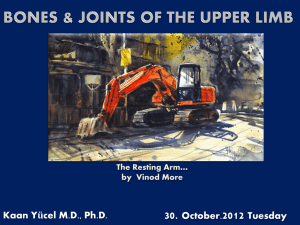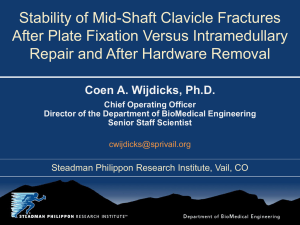Clavicle CORE Plating System Surgical Technique
advertisement
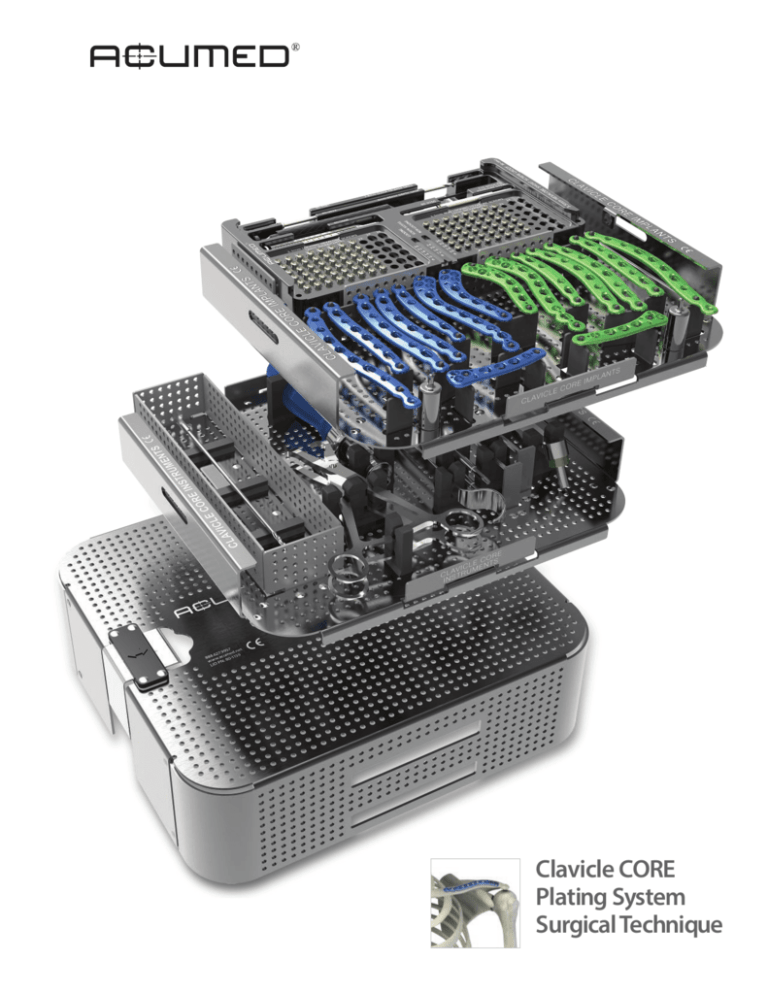
Clavicle CORE Plating System Surgical Technique Introducing the System Acumed® is a global leader of innovative orthopaedic and medical solutions. We are dedicated to developing products, service methods and approaches that improve patient care. The Clavicle CORE Plating System is a condensed version of the Acumed® Locking Clavicle Plating System. This set of 16 Locking Clavicle Plates is designed to treat both simple and complex fractures, malunions and nonunions, located from the medial-third to the distal-third of the clavicle. The Acumed® Clavicle CORE Plating System incorporates 16 of our most frequently used Locking Clavicle Plates, reducing the overall size of the set by including only what is necessary to complete a clavicle case. This system also features the Hexalobe Screw System which was designed to have maximized strength and a Hexalobe drive interface aimed to optimize performance in dense bone. The Clavicle CORE Plating System offers Distal and Superior Midshaft Clavicle Plates that are precontoured to match the natural S-shape of the clavicle. Designed in conjunction with William B. Geissler, M.D., the Acumed® Clavicle Plating System provides a comprehensive solution for repairing clavicle fractures. Contents Introducing the System 2 Plate Design 3 Hexalobe Screw Design 4 Clavicle CORE Plating System Tray 5 Clavicle CORE Plating System Surgical Techniques Locking Midshaft Clavicle Plates 7 Locking Distal Clavicle Plates 11 Ordering Information 14 Notes15 2 Plate Design Locking Superior Midshaft Plates 10° angled medial and lateral locking screw holes help aid screw insertion Limited contact undersurface intended to support healing of periosteum Low-profile plate/screw interface Locking holes Standard Larger compression/ compression/ reduction slots reduction slots Tapered plate ends designed to reduce risk of stress risers Beveled medial and lateral profile designed to minimize irritation Locking Distal Clavicle Plates Fixed angle locking screw holes, available for 3.5 mm screws .054” K-wire holes for provisional stability aid with accurate plate placement and are designed to prevent screws from passing into the AC Joint Suture holes allow for adjunct support and are intended to support healing for CC ligaments and AC joint injuries Locking holes Standard compression/ reduction slots 3 Hexalobe Screw Design Sleeveless “Stick-Fit” Driver Interface: Eliminates the need for a screw sleeve. The driver interfaces with the screw and “sticks”. Maximum Material Under Head: Designed to help reduce screw breakage. Hexalobe Drive Interface: Reduces the chance of stripping the screw. Type II Anodize: Material properties may aid implant removal. 4 Cutting Flute Design: May improve screw insertion. Clavicle CORE Plating System Tray 17 18 19 20 21 22 1 15 2 14 3 13 4 5 6 7 9 8 10 12 11 16 1 Low Prof Clavicle Plate, 10-hole, Left 70-0294 12 Low Prof Clavicle Plate, 8-hole Medium, Right 70-0291 2 Low Prof Clavicle Plate, 8-hole Straight, Left 70-0286 13 Low Prof Clavicle Plate, 8-hole Large, Right 70-0289 3 Low Prof Clavicle Plate, 8-hole Large, Left 70-0288 14 Low Prof Clavicle Plate, 8-hole Straight, Right 70-0287 4 Low Prof Clavicle Plate, 8-hole Medium, Left 70-0290 15 Low Prof Clavicle Plate, 10-hole, Right 70-0295 5 Narrow Prof Clavicle Plate, 6-hole, Left 70-0296 16 Low Prof Clavicle J-Plate, 8-hole, Right 70-0320 6 Distal Clavicle Plate 3.5 mm, 12-hole, Left 70-0112 17 2.8 mm Quick Release Surgibit(R) Drill 80-0387 7 Distal Clavicle Plate 3.5 mm, 9-hole, Left 70-0117 18 Depth Gage 6-65 mm 80-0623 8 Low Prof Clavicle J-Plate, 8-hole, Left 70-0319 19 2.8 mm Hexalobe Locking Drill Guide 6-65 mm 80-0668 9 Distal Clavicle Plate 3.5 mm, 9-hole, Right 70-0116 20 T15 Stick Fit Hexalobe Driver 10 Distal Clavicle Plate 3.5 mm, 12-hole, Right 70-0111 21 3.5 mm Locking Hexalobe Screws - 6-20 mm lengths 11 Narrow Prof Clavicle Plate, 6-hole, Right 70-0297 22 3.5 mm Nonlocking Hexalobe Screws - 6-20 mm lengths 80-0760 5 Clavicle CORE Plating System Tray 1 3 2 6 1 3.5 mm X 5” Quick Release Surgibit® Drill 2 4 5 6 7 8 MS-DC35 5 T15 6 inch Long Stick Fit Driver 80-1065 Reduction Forceps w/Serrated Jaw PL-CL04 6 .045” X 6” ST Guide Wire WS-1106ST 3 Medium Ratcheting Driver Handle 80-0663 7 .059" X 5" ST Guide Wire WS-1505ST 4 Clavicle Retractor PL-CL03 8 Offset Drill Guide PL-2095 Locking Midshaft Clavicle Plate Surgical Technique 1 Radiographic options for midshaft clavicle fractures Radiographic evaluation begins with an anteroposterior (AP) view to evaluate the acromioclavicular (AC) and sternoclavicular (SC) joints as well as the coracoclavicular (CC) ligaments. If thoracic structures obstruct the image, a 20° to 60° cephald-tilted view may be utilized. For displaced fracture fragments, especially in the event of a vertically oriented butterfly fragment, a 45° AP oblique view may be helpful. If subluxation or dislocation of the medial clavicle or the SC joint is suspected, a 40° cephalic tilt view (serendipity view) of the SC joint or CT Scan is recommended.1 If the decision on operative treatment is influenced by shortening of the clavicle, a Posterioranterior (PA) 15° caudal X-ray is suggested to assess the difference compared to the non-injured side.2 Preoperative Planning and Patient Positioning After completion of a thorough radiographic evaluation, the patient is placed in a beach chair position with the head rotated and tilted 5° to 10° away from the operative side. A bolster is placed between the shoulder blades and head allowing the injured shoulder girdle to retract posteriorly. This will facilitate reduction by bringing the clavicle anterior to restore length and improve exposure. The patient’s involved upper extremity is prepped and draped in a sterile fashion allowing the arm to be manipulated to help further reduce the fracture if required. 2 Exposure Surgeons may choose one of two incisions: option one, a 4 cm transverse (medial to lateral) intraclavicular incision is made parallel to the long axis and inferior to the clavicle so that the scar does not lie over the plate. This approach may provide convenient, unlimited access to the entire length of the bone. Option two, an incision along Langer’s Lines running perpendicular to the long axis may provide better cosmetic results and less damage to the supraclavicular cutaneous nerves. The subcutaneous fat is incised together with any fibers of the platysma. Identifying and protecting branches of the supraclavicular nerves preserves cutaneous sensation inferior to the incision. The pectoralis fascia is divided in line with the incision and elevated with electrocautery to create thick flaps that can be closed over the plate at the end of the procedure. Tip: It is important to keep soft tissue attachments to the butterfly fragments to maintain vascularity. 1 Bishai, S., Plancher, K., Areson, D. Operative Treatment for Comminuted Midshaft Fractures and Type II Distal Clavicle Fractures With Plating Techniques. Fractures of the Upper Extremity. American Society for Surgery of the Hand. 2008. 2 Renner et al, Scapula and Clavicle. AO Principles of Fracture Management. AO Publishing (Theime). 2007. 557-571. 7 Locking Midshaft Clavicle Plate Surgical Technique 3 Plate Selection Reduce the fracture by placing a Reduction Forceps (PL-CL04) on both the medial and lateral fragments. Distract, elevate and rotate the lateral fragment to obtain reduction. An appropriately sized left or right Locking Midshaft Clavicle Plate is selected from the different lengths and curvatures in the system. Place the two middle screw slots or holes on either side of the fracture line, ideally leaving three locking and/or nonlocking holes both medial and lateral to the fracture fragments. The plate may be slid medially or laterally to achieve the best fit. In cases of nonunion or malunion, the curve of the plate may assist in anatomic reduction of the clavicle, reducing strain on the SC and AC joints. Tips: For a more anatomical fit, the plate may be rotated 180° or a plate of the opposite dexterity may be used if the patient’s anatomy requires a different curvature than that provided by the designated plate. Prior to placement of the plate, lag screw fixation across the major fracture fragments may be performed. Reduction Forceps (PL-CL04) or Guide Wires (WS-1106ST or WS-1505ST) may be used to reduce and stabilize butterfly fragments to the main medial and lateral clavicle fragments. Drill the fragments utilizing a 3.5 mm Drill (MS-DC35) for the near cortex, followed by a 2.8 mm Quick Release Drill (80-0387) for the far cortex. Insert the appropriate length 3.5 mm Nonlocking Hexalobe Screw across the fracture to lag. If bending of the plate is necessary, please observe the following: ·· Do not bend plates more than 30° ·· Bend radii should be greater than 1 inch ·· Do not bend, unbend, and re-bend more than once ·· Avoid bending across locking holes Note: The PL-CL04 should be used for plate placement, but is not designed to be used to reduce the plate to the bone or to hold the plate while attempting to bend or contour it to match the patient’s anatomy. 4 Plate Placement Once the plate’s ideal position has been selected, it is provisionally stabilized to the clavicle with .045” or .059” Guide Wires (WS-1106ST or WS-1505ST). To reduce the risk of delayed union or nonunion, the plate should be applied in compression mode using the 2.8 mm Offset Drill Guide (PL-2095). The plate may be applied to one of the major fracture fragments and used as a tool to reduce other major fragments to this bone-plate construct. Take care to ensure that the intervening fragments are not stripped. Preservation of soft tissue attachments help ensure that the length and rotation of the clavicle are correct. 8 Surgical Technique by William B. Geissler, M.D. 5 Nonlocking Screw Insertion For early stability, the first two screws should be placed medial and lateral to the fracture site. If bicortical screws are used, precautions should be taken to avoid over-penetration of the inferior cortex. The Clavicle Retractor (PL-CL03) should be placed under the inferior surface of the clavicle to protect the neurovascular structures from over-penetration when drilling. Assemble the Medium Ratcheting Driver Handle (80-0663) to the T15 Hexalobe Driver (80-0760). Using the 2.8 mm Quick Release Drill (80-0387) and the Offset Drill Guide (PL-2095), drill, measure for depth (80-0623) and place the provided 3.5 mm Nonlocking Hexalobe Screws through the slots with the assembled driver. Once at least two screws are installed the Guide Wires holding the plate to the clavicle may be removed. Tip: Replace drill if it comes in contact with the Clavicle Retractor. 6 Locking Screw Insertion To drill all locking holes place the 2.8 mm Locking Drill Guide (80-0668) into the desired hole until the guide fully threads into the plate. When between sizes, it is recommended to choose the shorter screw option. Remove the Locking Drill Guide and insert the proper length screw. To place the 3.5 mm Locking Hexalobe Screws into the threaded holes, use the T15 Hexalobe Driver (80-0760) with the Medium Ratcheting Driver Handle (80-0663). Advance the screw until the head fully engages the plate. Tips: The outer most medial and lateral holes are angled 10° and the Locking Drill Guides must be inserted appropriately to account for these angles. Depending on the degree of comminution, demineralized bone matrix, iliac crest autograft, or allograft bone chips may be used to fill areas devoid of bone.3 In hypertrophic nonunions, callus from the nonunion site may be sufficient to provide graft material. 7 Final Plate and Screw Position An intraoperative radiograph is recommended to check the final reduction of the fracture and the position of the screws. If the surgeon feels the bone quality of the lateral fragment is poor, sutures may be passed from medial to lateral around the coracoid and the plate to take stress off of the lateral fixation. After radiographic evaluation and thorough irrigation, the clavipectoral fascia is closed over the clavicle and the plate, followed by closure of the subcutaneous tissue and musculature in separate layers. Finally, the skin is closed by using interrupted absorbable sutures with a subcuticular stitch and dress the wound. 3 Bishai et al. 9 Locking Midshaft Clavicle Plate Surgical Technique Post-op Protocol For the first four weeks, the patient is placed in either an arm sling or an abduction pillow to bring the arm up and the clavicle down, unloading the AC joint.4 Passive range of motion exercises are initiated during the first four weeks. Exercises may include pendulum, Codman, isometric bicep, and elbow and wrist motion. It should be emphasized to patients that they must avoid any activity involving heavy lifting, pushing or pulling. Depending on the amount of comminution and the stability of fixation, active assisted exercise is started from four to six weeks, and active strengthening is initiated at six to eight weeks postoperatively, once healing is seen radiographically. A full return to activities is permitted once healing has occurred. Indications: The Acumed® Congruent Bone Plate System includes plates, screws and accessories designed for clavicle, humerus, radius, ulna, metacarpal, metatarsal, malleolus, tibia, fibula, and scapula. Contraindications: Contraindications for the system are active or latent infection; sepsis; osteoporosis, insufficient quantity or quality of bone/soft tissue; and material sensitivity. If sensitivity is suspected, tests are performed prior to implantation. Patients who are unwilling or incapable of following postoperative care instructions are contraindicated for these devices. 5 These devices are not intended for screw attachment or fixation to the posterior elements (pedicles) of the cervical, thoracic, or lumbar spine. 4 5 10 Bishai et al. Altamimi, S., McKee, M. Nonoperative Treatment Compared with Plate Fixation of Displaced Midshaft Clavicular Fractures (Surgical Technique) Journal of Bone and Joint Surgery. 2008; 90 Supplement (part1): 1-8 Locking Distal Clavicle Plate Surgical Technique 1 Preoperative Planning and Patient Positioning After a thorough radiographic evaluation has been completed, the patient is placed in a beach chair position with the head rotated and tilted 5° to 10° away from the operative side. A bolster is placed between the shoulder blades allowing the injured shoulder girdle to retract posteriorly. This helps facilitate reduction by bringing the clavicle anterior to restore length and improve exposure. The patient’s involved upper extremity is prepped and draped in a sterile fashion allowing the arm to be manipulated to help further reduce the fracture if required. Tip: After axial trauma to the shoulder, it is important to complete a full clinical workup as this injury is not only a bony injury, but usually a soft tissue event involving the disruption of the coracoclavicular (CC) ligaments and acromioclavicular (AC) joint.6 Thus, examination of the AC joint and CC ligaments is important in the success of the repair. Note: Step 1 of the Midshaft Plate surgical technique provides a complete profile of options for radiographic evaluation. It is important to note that an AP radiograph can underestimate the displacement of the distal clavicle. If AC joint widening is visualized on the AP view, an axillary radiograph should be taken to determine the anteroposterior position of the clavicle in relation to the acromion.7 2 Exposure Surgeons may choose one of two incisions: option one, a 4 cm transverse incision is made inferior to the distal clavicle and AC Joint. The incision is usually placed midway between the medial and lateral migrations of the proximal fragment. Option two, an incision along Langer’s Lines running perpendicular to the long axis may provide better cosmetic results and less damage to the supraclavicular cutaneous nerves. Dissection is carried down to the fascia and the skin flaps are elevated. The cutaneous nerves are protected. The trapezial deltoid musculature is then subperiosteally elevated off the bone fragments avoiding the infraclavicular nerve branches below the clavicle. Tip: It is important to keep soft tissue attachments to the butterfly fragments to maintain vascularity. The fracture is then reduced. 6 Yeh, et al, Midshaft clavicle fracture and acromioclavicular dislocation: A case report of a rare injury. Journal of Shoulder and Elbow Surgery. 2008 December; Article in Press :1-4. 7 Yeh et al. 11 Locking Distal Clavicle Plate Surgical Technique 3 Plate Selection Select the appropriately sized Locking Distal Clavicle Plate from the different lengths and curvatures in the system. The curve of the plate may assist in anatomic reduction of the clavicle, reducing strain on the SC and AC joints. If bending of the plate is necessary, please observe the following: ·· Do not bend plates more than 30° ·· Bend radii should be greater than 1 inch ·· Do not bend, unbend, and re-bend more than once ·· Avoid bending across locking holes Tip: Prior to placement of the plate, lag screw fixation across the major fracture fragments may be performed. Many Type IIB clavicle fractures have a horizontal cleavage fracture that extends into the AC joint, which may be fixed in this manner. Reduction Forceps (PL-CL04) or Guide Wires (WS-1106ST or WS-1505ST) may be used to reduce and stabilize butterfly fragments to the main medial and lateral clavicle fragments. Drill the fragments utilizing a 3.5 mm Drill (MS-DC35) for the near cortex, followed by a 2.8 mm Quick Release Drill (80-0387) for the far cortex. Insert the appropriate length 3.5 mm Nonlocking Hexalobe Screw across the fracture to lag. 4 Plate Placement Once the plate’s ideal position has been selected, it is provisionally stabilized to the clavicle with Guide Wires (WS-1106ST or WS-1505ST). Under radiographic evaluation, the most lateral K-wire hole of each Locking Distal Clavicle Plate affords the opportunity to verify that the placement of the screws will not protrude into the AC joint. Note: The PL-CL04 should be used for plate placement, but is not designed to be used to reduce the plate to the bone or to hold the plate while attempting to bend or contour it to match the patient’s anatomy. 5 Nonlocking Screw Insertion For early stability, the first two screws should be placed medial and lateral to the fracture site. If bicortical screws are used, precautions should be taken to avoid over-penetration of the inferior cortex. The Clavicle Retractor (PL-CL03) should be placed under the inferior surface of the clavicle to protect the neurovascular structures from over-penetration when drilling. Assemble the Medium Ratcheting Driver Handle (80-0663) to the T15 Hexalobe Driver (80-0760). Using the 2.8 mm Quick Release Drill (80-0387) and the Offset Drill Guide (PL-2095), drill, measure for depth (80-0623) and place the provided 3.5 mm Nonlocking Hexalobe Screws through the slots with the assembled driver. To drill the distal cluster, the 2.8 mm Locking Drill Guide (80-0668) must be used in all of the holes. Once at least two screws are installed, the Guide Wires holding the plate to the clavicle may be removed. Tip: Replace drill if it comes in contact with the Clavicle Retractor. 12 Surgical Technique by William B. Geissler, M.D. 6 Locking Screw Insertion To drill all locking holes place the 2.8 mm Locking Drill Guide (80-0668) into the desired hole until the guide fully threads into the plate. When between sizes, it is recommended to choose the shorter screw option. Remove the Locking Drill Guide and insert the proper length screw. To place the 3.5 mm Locking Hexalobe Screws into the threaded holes, use the T15 Hexalobe Driver (80-0760) with the Medium Ratcheting Driver Handle (80-0663). Advance the screw until the head fully engages the plate. Tip: Depending on the degree of comminution, demineralized bone matrix, iliac crest autograft, or allograft bone chips may be used to fill areas devoid of bone.3 In hypertrophic nonunions, callus from the nonunion site may be sufficient to provide graft material. 7 Final Plate and Screw Placement An intraoperative radiograph is recommended to check the final reduction of the fracture and the position of the screws. If the surgeon feels the bone quality of the lateral fragment is poor or there is injury to the coracoclavicular ligaments, sutures may be passed from medial to lateral around the coracoid and through the suture holes in the distal portion of the plate to take stress off of the lateral fixation. After radiographic evaluation and routine irrigation, the trapezial-deltoid fascia is closed over the clavicle and AC joint, followed by closure of the subcutaneous tissue and skin. The wound is dressed and the arm placed in an abduction pillow to bring the arm up and the clavicle down, unloading the AC joint. Post-op Protocol Passive range of motion exercises are initiated during the first four weeks. Exercises may include pendulum, Codman, isometric bicep, and elbow and wrist motion. It should be emphasized to patients that they must avoid any activity involving heavy lifting, pushing or pulling. Depending on the amount of comminution and the stability of fixation, active assisted exercise is started from four to six weeks, and active strengthening is initiated at six to eight weeks postoperatively, once healing is seen radiographically. Full return to activities is permitted once healing has occurred. Indications: The Acumed® Congruent Bone Plate System includes plates, screws and accessories designed for clavicle, humerus, radius, ulna, metacarpal, metatarsal, malleolus, tibia, fibula, and scapula. Contraindications: Contraindications for the system are active or latent infection; sepsis; osteoporosis, insufficient quantity or quality of bone/soft tissue; and material sensitivity. If sensitivity is suspected, tests are performed prior to implantation. Patients who are unwilling or incapable of following postoperative care instructions are contraindicated for these devices.8 These devices are not intended for screw attachment or fixation to the posterior elements (pedicles) of the cervical, thoracic, or lumbar spine. 8 Altamimi et al. 13 Ordering Information Clavicle Plates Part # Distal Clavicle PLT 3.5 mm 12 Hole, Right 70-0111 Distal Clavicle PLT 3.5 mm 12 Hole, Left Qty Instrumentation Part # 1 .045" X 6" ST Guide Wire WS-1106ST 4 70-0112 1 .059 X 5" ST Guide Wire WS-1505ST 4 Distal Clavicle PLT 3.5 mm 9 Hole, Right 70-0116 1 3.5 mm X 5" Quick Release Surgibit® Drill MS-DC35 1 Distal Clavicle PLT 3.5 mm 9 Hole, Left 70-0117 1 2.8 mm Quick Release Surgibit® Drill 80-0387 2 Low Prof Clavicle Plate, 8-hole Str Left 70-0286 1 2.8 mm Hexalobe Lkg Drill Guide 6-65 mm 80-0668 1 Low Prof Clavicle Plate, 8-hole Str Rt 70-0287 1 T15 Stick Fit Hexalobe Driver 80-0760 2 Low Prof Clavicle Plate, 8-hole Lg Left 70-0288 1 T15 6 in Long Stick Fit Driver 80-1065 1 Low Prof Clavicle Plate, 8-hole Lg Rt 70-0289 1 Depth Gage 6-65 mm 80-0623 1 Low Prof Clavicle Plate, 8-hole Md Left 70-0290 1 Medium Ratcheting Driver Handle 80-0663 1 Low Prof Clavicle Plate, 8-hole Md Rt 70-0291 1 Offset Drill Guide PL-2095 1 Low Prof Clavicle Plate, 10-hole Left 70-0294 1 Clavicle Retractor PL-CL03 1 Low Prof Clavicle Plate, 10-hole Rt 70-0295 1 Reduction Forceps w/Serrated Jaw PL-CL04 2 Nrw Prof Clavicle Plate, 6-hole Left 70-0296 1 Nrw Prof Clavicle Plate, 6-hole Rt 70-0297 1 Tray System Low Prof Clavicle J-Plate, 8-hole Left 70-0319 1 3.5 mm Hexalobe Short Screw Caddy Lid 80-0856 1 Low Prof Clavicle J-Plate, 8-hole Right 70-0320 1 3.5 mm Hexalobe Short Screw Caddy 80-0843 1 Clavicle CORE Instrument Tray 80-1161 1 Clavicle CORE Implant Tray 80-1160 1 Clavicle CORE Tray Lid 80-1159 1 3.5 mm Locking Hexalobe Screws 3.5 mm x 6 mm Locking Hexalobe Screw 30-0231 6 3.5 mm x 8 mm Locking Hexalobe Screw 30-0232 6 3.5 mm x 10 mm Locking Hexalobe Screw 30-0233 6 3.5 mm x 12 mm Locking Hexalobe Screw 30-0234 6 3.5 mm x 14 mm Locking Hexalobe Screw 30-0235 6 3.5 mm x 16 mm Locking Hexalobe Screw 30-0236 6 3.5 mm x 18 mm Locking Hexalobe Screw 30-0237 6 3.5 mm x 20 mm Locking Hexalobe Screw 30-0238 6 3.5 mm x 6 mm Nonlocking Hexalobe Screw 30-0254 6 3.5 mm x 8 mm Nonlocking Hexalobe Screw 30-0255 6 3.5 mm x 10 mm Nonlocking Hexalobe Screw 30-0256 6 3.5 mm x 12 mm Nonlocking Hexalobe Screw 30-0257 6 3.5 mm x 14 mm Nonlocking Hexalobe Screw 30-0258 6 3.5 mm x 16 mm Nonlocking Hexalobe Screw 30-0259 6 3.5 mm x 18 mm Nonlocking Hexalobe Screw 30-0260 6 3.5 mm x 20 mm Nonlocking Hexalobe Screw 30-0261 6 3.5 mm Nonlocking Hexalobe Screws 14 Qty Notes: 15 5885 NW Cornelius Pass Road Hillsboro, OR 97124 (888) 627-9957 www.acumed.net Distributed by: SHD10-03-A Effective: 9/2012 © 2012 Acumed® LLC These materials contain information about products that may or may not be available in any particular country or may be available under different trademarks in different countries. The products may be approved or cleared by governmental regulatory organizations for sale or use with different indications or restrictions in different countries. Products may not be approved for use in all countries. Nothing contained on these materials should be construed as a promotion or solicitation for any product or for the use of any product in a particular way which is not authorized under the laws and regulations of the country where the reader is located. Specific questions physicians may have about the availability and use of the products described on these materials should be directed to their particular local sales representative. Specific questions patients may have about the use of the products described in these materials or the appropriateness for their own conditions should be directed to their own physician.
